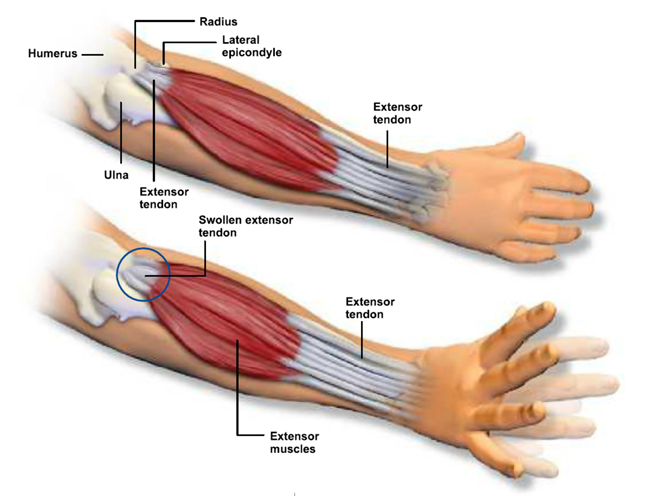Tennis elbow - the basics.
Tennis elbow
"Tennis elbow" is a phrase used by doctors to describe elbow pain. It is common in manual workers and sports people (particularly tennis players!) and it usually consists of a stabbing pain on the outside of the elbow coupled with a deep ache in the forearm. Unfortunately this condition is often misdiagnosed, with other similar conditions around the elbow being incorrectly classed as "tennis elbow".
Tennis elbow in its simplest form is a tendinopathy / tendonitis. This means there is an issue with the tendon that connects the muscles which lift the hand (wrist extensors) to the outside tip of the elbow (the lateral epicondyle). If it has come on recently (less than 2 weeks ago) there may be some inflammation present, however if you have had it for longer, then the tendon itself may exhibit a little wear. The most common cause of this condition is overuse. This means the muscles of the forearm cannot cope with the workload being placed upon them and the tendon near the origin of the muscle becomes strained.
Unfortunately tennis elbow is not always straight forward. There are a few other conditions that need to be assessed for and ruled out when addressing tennis elbow.

"Tennis elbow" is a phrase used by doctors to describe elbow pain. It is common in manual workers and sports people (particularly tennis players!) and it usually consists of a stabbing pain on the outside of the elbow coupled with a deep ache in the forearm. Unfortunately this condition is often misdiagnosed, with other similar conditions around the elbow being incorrectly classed as "tennis elbow".
Tennis elbow in its simplest form is a tendinopathy / tendonitis. This means there is an issue with the tendon that connects the muscles which lift the hand (wrist extensors) to the outside tip of the elbow (the lateral epicondyle). If it has come on recently (less than 2 weeks ago) there may be some inflammation present, however if you have had it for longer, then the tendon itself may exhibit a little wear. The most common cause of this condition is overuse. This means the muscles of the forearm cannot cope with the workload being placed upon them and the tendon near the origin of the muscle becomes strained.
Unfortunately tennis elbow is not always straight forward. There are a few other conditions that need to be assessed for and ruled out when addressing tennis elbow.

Treatment
Tennis elbow rarely needs masses of treatment initially, having said that, it does generally take a long time to get rid of the symptoms completely. More often than not the sooner you seek treatment after onset the quicker and more effective treatment will be. The elbow will need to be accurately assessed by a physiotherapist who will treat the muscle and tendon initially and then start you on a stretching and strengthening program to continue at home.
Corticosteriod injections
These used to be used a lot for the treatment of tennis elbow. However scientific evidence now suggests that although they will reduce the pain in the short term (within the first 2-4 weeks) those who receive an injection will be 62% more likely to have a reoccurrence of the condition within 12 weeks than those who treated the condition with physiotherapy. (Coombes BK, Bisset L, Vicenzino B, Efficiency and safety of corticosteroid injections and other injections for management of tendinopathy: a systematic review of randomised controlled trials. Lancet 2010;367(9754)
As with any condition relating to muscles, tendons, or joints, give yourself the best chance of recovery by seeing the experts in this field - physiotherapists. For more information or to book an appointment please call us on 01271 269371
Tennis elbow rarely needs masses of treatment initially, having said that, it does generally take a long time to get rid of the symptoms completely. More often than not the sooner you seek treatment after onset the quicker and more effective treatment will be. The elbow will need to be accurately assessed by a physiotherapist who will treat the muscle and tendon initially and then start you on a stretching and strengthening program to continue at home.
Corticosteriod injections
These used to be used a lot for the treatment of tennis elbow. However scientific evidence now suggests that although they will reduce the pain in the short term (within the first 2-4 weeks) those who receive an injection will be 62% more likely to have a reoccurrence of the condition within 12 weeks than those who treated the condition with physiotherapy. (Coombes BK, Bisset L, Vicenzino B, Efficiency and safety of corticosteroid injections and other injections for management of tendinopathy: a systematic review of randomised controlled trials. Lancet 2010;367(9754)
As with any condition relating to muscles, tendons, or joints, give yourself the best chance of recovery by seeing the experts in this field - physiotherapists. For more information or to book an appointment please call us on 01271 269371